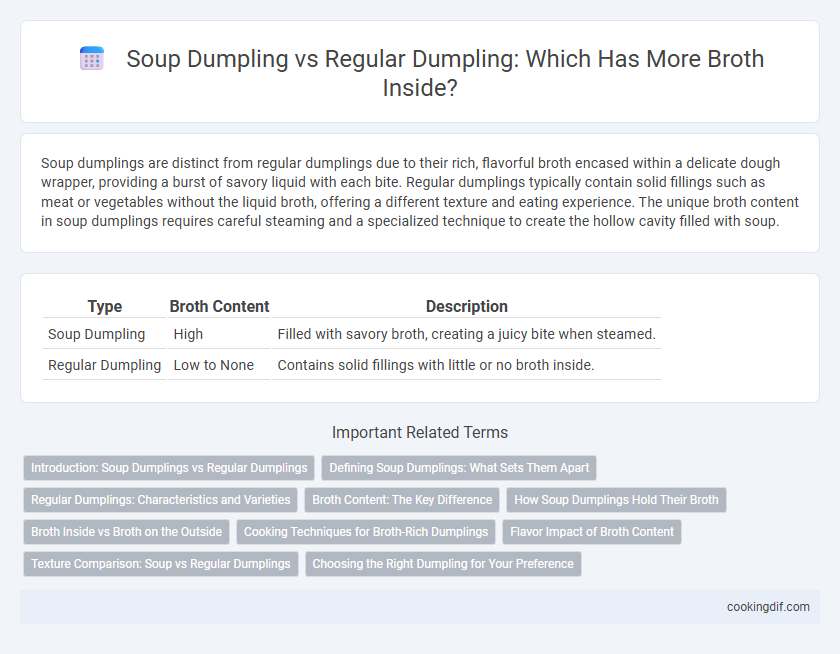Soup dumplings are distinct from regular dumplings due to their rich, flavorful broth encased within a delicate dough wrapper, providing a burst of savory liquid with each bite. Regular dumplings typically contain solid fillings such as meat or vegetables without the liquid broth, offering a different texture and eating experience. The unique broth content in soup dumplings requires careful steaming and a specialized technique to create the hollow cavity filled with soup.
Table of Comparison
| Type | Broth Content | Description |
|---|---|---|
| Soup Dumpling | High | Filled with savory broth, creating a juicy bite when steamed. |
| Regular Dumpling | Low to None | Contains solid fillings with little or no broth inside. |
Introduction: Soup Dumplings vs Regular Dumplings
Soup dumplings contain a rich, savory broth inside their delicate dough wrapper, creating a juicy burst of flavor with each bite. Regular dumplings typically feature a firmer filling without liquid, emphasizing texture over broth content. The key difference lies in the soup dumpling's unique ability to deliver a flavorful broth experience, setting it apart from traditional dumplings.
Defining Soup Dumplings: What Sets Them Apart
Soup dumplings, also known as xiao long bao, are characterized by their delicate, thin dough that encases a flavorful broth along with the filling, creating a unique, juicy experience. Unlike regular dumplings, which typically contain solid fillings without liquid, soup dumplings are crafted with a gelatinized broth that melts into soup when steamed. This technique sets soup dumplings apart, making them prized for their distinctive blend of rich broth and savory meat or vegetable filling within a single bite.
Regular Dumplings: Characteristics and Varieties
Regular dumplings, unlike soup dumplings, typically have a thicker wrapper and are filled with solid ingredients such as minced pork, vegetables, or seafood, resulting in little to no broth inside. Varieties include boiled, steamed, and pan-fried dumplings, each offering distinct textures from tender to crispy. Popular types like jiaozi and gyoza showcase regional fillings and cooking methods emphasizing savory, hearty flavors without the liquid interior characteristic of soup dumplings.
Broth Content: The Key Difference
Soup dumplings contain a rich, flavorful broth sealed inside a thin dough wrapper, which bursts in the mouth when bitten, delivering a unique savory experience. Regular dumplings typically lack this internal liquid, focusing instead on solid fillings such as meat, vegetables, or seafood without the enhanced juiciness of broth. The presence of hot, savory soup in soup dumplings distinguishes them by providing a moist, aromatic burst of flavor unmatched by traditional dumpling varieties.
How Soup Dumplings Hold Their Broth
Soup dumplings, also known as xiao long bao, are uniquely designed with a delicate, thin dough that encases flavorful broth and meat, allowing the liquid to remain sealed inside until bitten into. This broth is created by incorporating gelatinized meat stock that melts during steaming, maintaining a juicy and soupy filling distinct from regular dumplings. In contrast, regular dumplings usually contain a solid, mixed filling without enclosed broth, resulting in a drier texture compared to the rich, savory soup inside soup dumplings.
Broth Inside vs Broth on the Outside
Soup dumplings contain rich, flavorful broth sealed inside a thin, delicate wrapper, creating a burst of hot soup with each bite. Regular dumplings are typically filled with solid ingredients and served with broth or sauce on the outside, offering a contrasting texture without the enclosed liquid center. The key difference lies in soup dumplings' ability to deliver the broth internally, enhancing the eating experience through a savory, steaming liquid surprise.
Cooking Techniques for Broth-Rich Dumplings
Soup dumplings, or xiao long bao, are crafted using a delicate dough encasing gelatinized broth that melts upon steaming, creating a rich, flavorful soup inside. Regular dumplings typically contain a solid filling without broth, relying on steaming or pan-frying techniques that do not melt gelatinized stock. Mastery of careful steaming and dough elasticity is essential for soup dumplings to maintain their broth-rich interior without leakage or breakage.
Flavor Impact of Broth Content
Soup dumplings, also known as xiao long bao, contain a rich, savory broth encapsulated within a thin dough wrapper, creating an intense burst of flavor when bitten into, which significantly enhances the overall taste experience. Regular dumplings typically lack internal broth, resulting in a firmer texture with flavors concentrated in the filling rather than a juicy, soup-like sensation. The broth content in soup dumplings adds a unique umami richness and moisture that elevates the dish's flavor complexity, setting it apart from traditional dumplings.
Texture Comparison: Soup vs Regular Dumplings
Soup dumplings, or xiao long bao, feature a delicate, thin wrapper that encases hot, flavorful broth, offering a burst of savory liquid with each bite, creating a soft and juicy texture. Regular dumplings generally have a thicker outer layer, resulting in a chewier texture that complements denser fillings, but lack the liquid broth, making them more solid and substantial. The contrast in texture highlights the soup dumpling's silky, tender skin and juicy interior versus the regular dumpling's hearty, doughy exterior and firmer bite.
Choosing the Right Dumpling for Your Preference
Soup dumplings, also known as xiao long bao, contain a delicate broth inside a thin, translucent wrapper, offering a savory burst of liquid with each bite. Regular dumplings typically have a thicker dough and are filled with solid ingredients such as pork, vegetables, or shrimp, resulting in a chewier texture without the soupy interior. Choosing between soup dumplings and regular dumplings depends on your preference for a juicy, soup-filled experience or a heartier, more substantial filling.
Soup Dumpling vs Regular Dumpling for Broth Content Infographic

 cookingdif.com
cookingdif.com